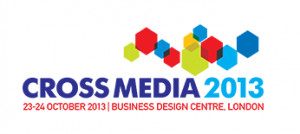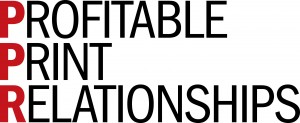Since I don’t get to go to ALL the shows I wish I could attend, I am very fortunate that I can ask some great people to do a little recon for us. Such is the case with Matthew Parker and the Cross Media Show which just took place in London. He also reported for us on this show last year! I think his takeaways are totally on point, but would love to know what you think… is the industry STILL talking to itself? Are we confusing customers and ourselves? Leave your comments below!

By Matthew Parker
The CrossMedia show in London is always a worthwhile event. This year the show seemed busier than ever, almost outgrowing its venue. Despite the relatively small size of the show it attracted visitors from a wide range of countries.
As ever, the seminar theatres were generally packed out. So what were the key learnings that I took away from the event? Here are six trends that I saw from my time at the show.
There is no new huge technological shift
Some of the exhibitors may take exception to this and feel that I have missed some new feature of their offering. However, the truth is that we are still talking about the same channels of communication as we were 12 months’ ago.
The main change is that people at the show were talking about augmented reality more. The concept is definitely becoming more familiar to more people. The technology had a much greater presence at the show. Nevertheless I did not see evidence of widespread use of the technology yet. That is not totally surprising given the next trend that I saw.
 The term Cross Media is not universally recognised
The term Cross Media is not universally recognised
One of the more interesting tweets about the show was from @davidbaldaro. He asked: “Does anyone outside the print industry actually know what cross media is and would they talk to their printer?”
It’s a very valid point. I had several discussions about what we should call this blend of technology and ideas. Traditional marketing folk are probably more used to the term “multitouch marketing”. Many suppliers refer to individual product names instead of a generic cross media term. We need to decide what to call this type of communication. It’s confusing for the end client. And that’s not the only thing that’s confusing.
We need to offer customers a product
One attendee asked me what Cross Media was. He wasn’t talking about the term. He was more confused about what he should be selling. He found it difficult to get the idea across to his prospects and clients.
Sometimes I feel we offer customers too much choice. We are still in the early years of Cross Media. It is often better to offer someone a very defined product. Too often, we tell someone that we sell Cross Media and ask them what they would like! Clients is more likely to make a decision to use this type of communication if they don’t have to create a specification first.
We also need to remember that we are unlikely to convert the customer if we offer them something too complicated, too soon.

It’s a journey of small steps
It’s tempting to jump in and offer someone a complete solution with all the bells and whistles. But the truth is, most suppliers and most customers are still very much at the beginning of their learning journey.
At my presentation “How to raise Cross Media prices by 10%: lessons from Apple Computing” I talked about the need for a customer journey. Nowhere is this more true than in the Cross Media arena. We should start by offering clients simple solutions, such as a true variable data peace. As the client buys more a more into the concept and understands it we can start adding new features, such as personalised URLs. This learning journey echoes the next trend I saw.
Many people are at an early stage of their education
Most people at the show were there to learn rather than buy. Many of the questions that I came across were quite basic. There were a number of printers that I spoke to he didn’t know anything about Cross Media and I come to the show because they felt they ought to learn more. The same is true of some customers.
Even where people knew a technology well, there wasn’t always true understanding of how it fitted in with other channels of communication. However, there was one channel that everyone agreed was important.
Print is still a vital part of the mix
I was honoured to be asked to sit in on a panel hosted by Canon where we discussed if print was still relevant in today’s communication mix. The overwhelming conclusion was that it is.
There are many case studies and practical examples of how print is still generating a huge return on investment for companies that use it. However, what was also clear was that the true power of print comes into force when it is used with other channels of communication as well.
At the end of the day, despite all the confusion about names, technologies and what we are selling, that’s what Cross Media is all about.
I’d like to congratulate Informa on an excellent show. I’m looking forward to CrossMedia 2014.












3 Responses
Thanks for a good summary Matthew. It does have echoes of conversations so long ago. In general terms, so many ‘printers’ have still to catch up. Perhaps the terms of reference might be better understood if we talked ‘Customer Media’ rather than ‘Cross Media’? I think we all get that, don’t we?
Matthew as I was unfortunately unable to attend this is a very good summary on what I have heard from others who did make it. Once again the ‘print industry’ seems to have gone off and generated a language of its own expecting others to understand it. The term Cross Media seems to have confused the expected users as did the term TransPromo – when will we learn to keep it simple.
James, Nigel, thanks for your comments. I think there are a number of issues with how the print industry is selling “cross media”.
– Focused on the technology, not the end result
– not realising they need to educate the customer: many don’t understand the concept
– not having decent case studies
And that’s just for starters!
I do think that we have incredible potential here. However the industry needs to be cleverer about the way it promotes it.
Matthew